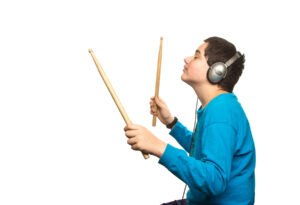You don’t need a full drum kit to become a strong drummer. As teachers who work with beginner percussion students every day, we’ve seen some of our most consistent progress come from students who practice creatively—on couches, desktops, and even knees.
This guide shows you how to practice drums without a drum set using simple tools, creative techniques, and structured routines. Whether you’re waiting for your first drum kit or just trying not to drive the neighbors crazy, you’ve got options.
Your No-Kit Practice Toolkit
Here are our go-to tools for quiet, portable, and effective drum practice at home.
1. Practice Pad
A must-have for every drummer.
- Mimics rebound and feel of a real drum
- Portable and quiet
- Great for rudiments, warm-ups, and control
Bonus: You can place it on a desk or snare stand and use regular sticks.
2. Sticks + Pillow
Yes—just a pillow! Great for building strength because there’s no rebound.
- Use for single strokes, doubles, and flams
- Focuses on stick control and wrist development
3. Body Percussion
Use your body as your drum kit.
- Tap thighs, chest, and clap for different “voices”
- Build coordination and groove with simple patterns
- Try beatboxing or vocalizing rhythms for ear training
Check out Vic Firth’s free online drum lessons for exercises you can do without a full kit.
What to Practice Without a Kit
Here’s a rhythm-focused routine you can follow 3–5 times a week.
Warm-Up (5 mins)
- Single strokes on pad or pillow
- Slow doubles and paradiddles
Timing + Groove (5–10 mins)
- Practice with a metronome or drum loop
- Play simple grooves using your lap or table (e.g., kick-snare patterns)
- Tap along to a favorite song and match the beat
Reading + Rudiments (5 mins)
- Read basic rhythms aloud
- Clap or tap them with one hand, then two
Looking for more rhythm-building tips? Read our blog on why rhythm matters for guitar—the concepts apply to all instruments!
FAQ: Practicing Drums Without a Kit
Can I really improve without a drum set?
Yes! Coordination, timing, and control can all be developed away from the kit. You’ll progress faster when you finally sit down to play.
What age is best to start this way?
Kids as young as 5 can start learning rhythms, sticking, and listening skills using practice pads and body percussion.
Should I wait to buy a drum set before starting lessons?
Not at all. Lessons can begin with just a pad, sticks, and your hands. Your teacher will guide you through age-appropriate exercises and materials.
